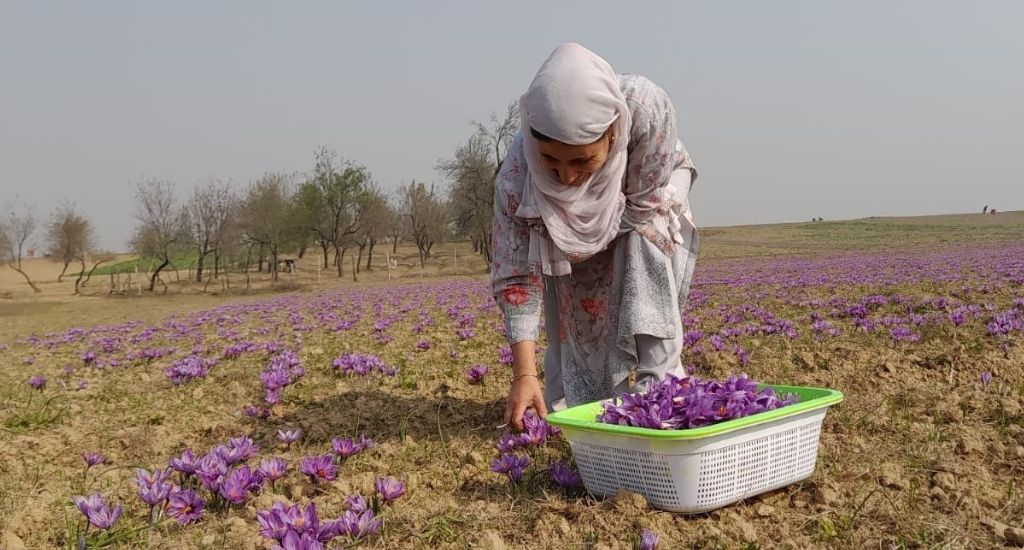
Kashmir stares at a saffron sunset
Pampore, the hub of Kashmiri saffron, casts a gloomy picture as production of the prized spice declines due to climate change, encroachment of fields, inadequate irrigation and intrusion of cheaper Iranian variants

Pampore, the hub of Kashmiri saffron, casts a gloomy picture as production of the prized spice declines due to climate change, encroachment of fields, inadequate irrigation and intrusion of cheaper Iranian variants
Under the winter sun’s waning warmth, the purple hue of saffron fields in Pampore of Jammu and Kashmir reflect a contrasting picture of anticipation and anxiety. Pampore is the primary hub for saffron cultivation in the region. As autumn concludes, families engage in a race against time to harvest the crocus flowers, which bloom for just a fortnight annually.
But this season’s prospects bear a disheartening truth for farmers like 62-year-old Mohammad Ismail Bhat. The saffron fields, usually bustling with the harvest, sit almost barren. Amidst a chorus of concerns, the tale echoes the sentiments of many, reflecting a sharp decline in Kashmir’s prized saffron yield.
“Every season, I yearn for a bountiful yield, but each time, hope withers away,” lamented Abdul Ahad Rather, another grower from Pampore.

Across generations, families once revelled in the harvest from October-end to mid-November. Men, women, and children painstakingly gather the delicate flowers, stooping and placing them in wicker baskets. The womenfolk hand-separate the purple petals, extracting three tiny, delicate stigmas from each flower. These stigmas are then sun-dried, transforming into one of the most expensive and sought-after spices globally.
Producing a kilogram necessitates the stigmas of approximately 1.50 lakh flowers, commanding a substantial price, often exceeding Rs 2.5 lakh a kg.
However, with dwindling produce, the wicker baskets of yore have surrendered to the modest confines of polythene bags. “There were days when I collected flowers in a basket. But now, a small bag is large enough for our saffron produce,” said Jameela, a middle-aged saffron picker.
Also Read: Another autumn of uncertainty for Kashmir’s saffron farmers
Saffron finds application worldwide in diverse products, ranging from food and medicine to cosmetics. In Kashmir, it’s prominently featured in kehwa, a slow-brewed sugary green tea, garnished with almonds. Saffron also plays a crucial role in wazwan, a traditional Kashmiri wedding feast comprising over 30 dishes.

The land, once abundant with blooms, now presents a stark contrast. In the 1990s, the average yield was more than 6 kg a hectare. Data from the agriculture department shows that saffron production plummeted from 16 metric tonnes in 1997 to 5 metric tonnes in 2020.
Earth science expert Dr Shakil Ramshoo attributed this decline to climate change. “Erratic weather conditions, particularly the diminishing autumn rainfall, have severely impacted the critical flowering stage of saffron,” he said.
Climate change, coupled with shrinking cultivable land, presents a double blow to the once-flourishing saffron fields cradled by low mountains. The saffron landscape, once sprawling across 5,707 hectares in 1996, dwindled to 1,116 hectares in 2020, as construction encroached upon the fertile karewas — flat-topped mounds dotting the Valley.
Explaining the reduction of more than 60 percent acreage under saffron cultivation, Moin Ahmad, an economics scholar from Pampore, said: “Forget others, rampant construction of houses on karewa land over the past decades has been evident in our village. Several new houses have come up on saffron fields.”
Also Read: Shielding trout from climate change in Kashmir

The surge in pollution levels, especially from cement factories in Khrew near Pampore, has also contributed to the decline in saffron yields. Farmer Ghulam Rasool Mir from Khrew echoed this concern, noting how cement factory emissions stifle the flower’s growth.
In Kashmir, saffron stands as a source of pride, shaping the region’s economy and culture for centuries. However, challenges such as climate change, inadequate irrigation facilities, and the influx of cheaper Iranian saffron have posed threats over the years.
As returns diminish and production falters, many growers abandon saffron cultivation in favour of horticulture, converting their fields into apple and plum orchards.

“After seasons of poor yield, I switched to plum cultivation,” Ashaq Hussain Dar, a farmer from Balhama village, said.
In 2010-11, the government intervened through the National Saffron Mission, which aimed to bolster irrigation. But farmers lament the programme’s limited impact.
“Though bore wells now dot our fields, the difference in production remains marginal,” said Mushtaq Ahmad Ganie from Lethpora village, advocating for a more substantial effort to salvage this crop.
Experts consider genetically modified saffron as a potential solution. However, senior scientist Dr Mehraj-u-Din of SKUAST-Kashmir underscored the challenges posed by the crop’s sterile nature, its sole reliance on vegetative propagation complicating any genetic modification attempts.
Also Read: American saffron emerges as an alternative crop to opium

From bustling markets to quiet kitchens, saffron weaves its golden thread through Kashmir’s culture and commerce. Here, it’s not merely a spice. It’s a heritage. Yet, as the sun sets on the fields of Pampore, the tale of decline weaves a poignant narrative, highlighting the fragile balance between nature’s bounties and human intervention.
Watch: Kashmir’s walnut harvesters are in danger
The lead image at the top shows Mumtaza Bano, a saffron grower in her field at Khrew village near Pampore in Jammu and Kashmir. (Photo by Nasir Yousufi)
Nasir Yousufi is a journalist based at Srinagar.